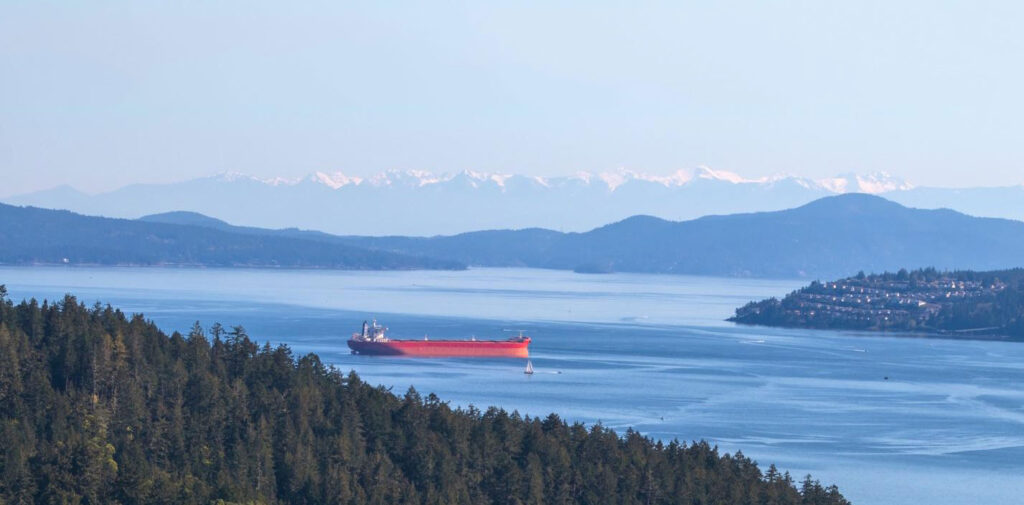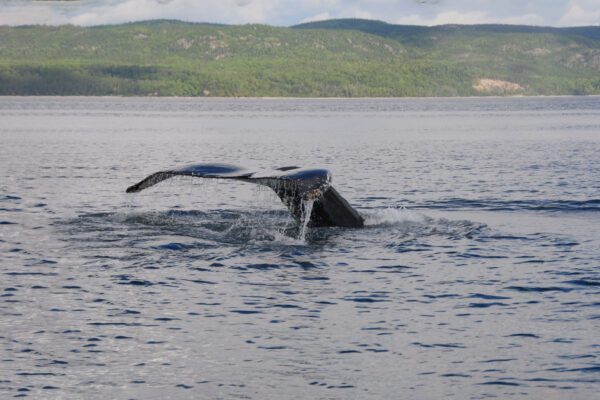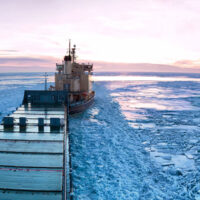John Thomas probably loves his job more than most people. But for this proud member of the Tsleil-Waututh Nation, it’s never just a regular day at the office.
It often means going out in the stormy waters of the Salish Sea as part of the Canadian Coast Guard’s environmental response team, riding the pollution response vessel CCG ER 701 to tackle an oil spill or marine mishap. The boat is powered by twin, high-powered 8.1 litre John Deere engines that are ready to take on the roughest conditions. And his face lights up when he recounts just how tough those conditions can be: “When you are down below and look out the window and all you see is green water, you know it’s a going to be a wild ride.”
As he describes what led him to a career in the Coast Guard, he says that his role as an environmental response specialist proved to be a major turning point in his life. “When I go to bed, I can’t wait to wake up and go back out,” the 36-year-old proud husband and father confides.

Touring the base on the coastal delta around Richmond, BC, he shares his passion for the different types of equipment they pull into service to deal with mostly small-craft oil spills using an array of pumps to booms and landing craft. There’s also lots of absorbent pads to soak up the oil, which then must be carefully transferred to large bags for disposal at an approved site. This is where new hires prove their worth by not overloading the bags since they can break as they are hauled over long distances for removal, he says with an insider’s grin of someone who’s been there before.
That takes him back to his early days when he was in the tree removal industry and was offered an internship by the Nation. “So really, at the last minute I took the opportunity for a change and the six-month internship started shortly after. It’s been six and a half years and I haven’t looked back. This was probably the best decision I’ve ever made, and the timing couldn’t have been better.” Later, he tells us that others – especially Indigenous Peoples – should take the opportunity if given the chance: “How will you know what’s behind the door if you don’t open it?”
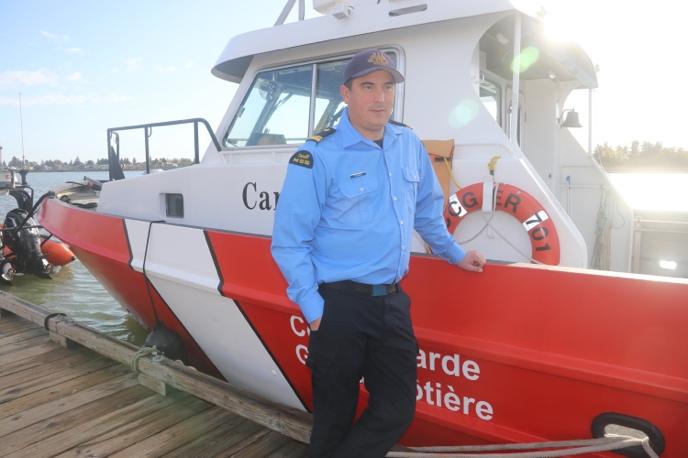
So far this year (late October 2022), the Coast Guard’s Environmental Response region which stretches from the southern BC coast, to Victoria, north and east as far Lake Winnipeg has had more than 900 calls, mostly small oil spills. He recounts how he was “up close and personal” with the MV Zim Kingston, a ship that lost more than 100 containers and experienced a persistent chemical fire off Vancouver Island, in October 2021. Sometimes he is called out on an operation in Burrard Inlet, in the shadow of the Trans Mountain (TMX) terminal. To save time, a Coast Guard crew will often pick him up near his traditional territory at Whey-Ah-Whichen (Cates Park) which means ‘facing the wind’ and he swings into operation, on shifts that can last days.
“As an Indigenous person in the Canadian Coast Guard, I feel lucky because of the experiences and people I’ve met through this journey,” he says. “We have a beautiful coast that I didn’t really know other than the waters of my Nation: Burrard Inlet, English Bay, False Creek, and parts of the Fraser River. My eyes were opened, and I got to travel the coast and waters of other First Nations. Through different courses and training the Coast Guard has offered me or sent me to, I’ve got to meet a lot of great people, First Nations, and others, and have always felt comfortable in any situation.”
Canada’s efforts to come to terms with its relationship with Indigenous Peoples are taking on greater importance as the marine shipping industry, government and ports explore new programs. It has been more than two years since Clear Seas released its first article on reconciliation in Canada’s marine shipping industry. Originating in the Truth and Reconciliation Commission (TRC) report of 2015, the issue of reconciliation was thrust into the headlines in 2021 as Canada confronted the legacy of its residential schools and the discovery of undocumented graves of Indigenous children across the country. As these stories of neglect, abuse and death continued to receive coverage, people and organizations across the country worked to come to terms with this dark time.
The issue of reconciliation is particularly relevant for the marine shipping industry as it touches the lives of Indigenous Peoples everywhere. Pollution and underwater noise from ships, black carbon from ship engines in the Arctic, and wakes from ships on the Great Lakes and other waters can affect their economic development, culture, history, and hunting patterns of Indigenous communities.
In conducting its annual overview, Clear Seas reached out to a range of marine related organizations across Canada to find out about initiatives that they have taken to address the issue. We thank those who were able to respond and provide an update. While it is not an exhaustive list of achievements or activities, it does provide a summary of some of the work that has been done on the path to reconciliation.
Canada’s Oceans Protection Plan opens doors to and for Indigenous Peoples
In 2022, the Government of Canada renewed funding for the Oceans Protection Plan (OPP), committing to provide $2 billion over nine years in an effort to protect Canada’s coasts and waterways. One of the key objectives of the OPP is to “advance partnerships and training opportunities for Indigenous and coastal communities to incorporate their expertise and experiences in various aspects of marine safety and ecosystem protection.” Some of these partnerships and training opportunities funded under the OPP include the Marine Training Program, search and rescue training opportunities for Indigenous communities, and the Indigenous Community Boat Volunteer Program.
In late 2022, the federal government released a review of the results of the first five years of the Oceans Protection Plan. This included a report on partnerships with Indigenous Peoples in protecting waterways and oceans. In releasing the update, Minister of Transport Omar Alghabra noted: “Collaboration with Indigenous Peoples, coastal communities, scientists, and the marine industry has been the cornerstone of the Oceans Protection Plan. During the first five years of the Oceans Protection Plan, we made significant progress in marine safety and emergency response, protecting our ecosystems and marine wildlife, and building partnerships with Indigenous Peoples and coastal communities. Our work is not done, and I look forward to more results from the Oceans Protection Plan in the years to come.”
A new program funded by the OPP will support the development of the Heiltsuk Marine Emergency Response Team on Canada’s West Coast. With the goal of enhancing the Heiltsuk Nation’s role in marine environmental response, this pilot project will include activities such as “on-water exercises and training, procuring equipment, and developing response strategies within the Heiltsuk territory.” This collaboration not only aims to enhance environmental preparedness along the coast, but also to strengthen nation-to-nation relationships by working together to protect the marine environment.
Another important milestone occurred in late 2022 when the North Coast Waterway Management Guidelines were established. They were the result of nearly three years of planning by the Government of Canada, the Gitga’at Nation, and the Gitxaala Nation, working together under the Reconciliation Framework Agreement for Bioregional Oceans Management and Protection, supported by Canada’s Oceans Protection Plan. They were developed as a pilot project of the Proactive Vessel Management initiative with considerable participation and support from collaborators including the BC Coast Pilots, Pacific Pilotage Authority, commercial shipping associations, and export terminal operators.
The Gitga’at and Gitxaala Nations have occupied the lands and waters around their coastal communities of Hartley Bay and Kitkatla, on the North Pacific Coast for millennia. According to a government news release, “Their use of the waterways to travel to and access fishing and marine harvesting areas is a key facet of their rich culture and history. That is why ensuring those activities can continue is essential to maintaining their cultural, social, and economic wellbeing. In that context, increased use of those waterways for commercial marine transportation, a mainstay of Canada’s economy, can present challenges.”
The guidelines apply to all types of vessels travelling between Kitimat, BC, and Browning Entrance and include safety zones, speed reductions, recommended routing, guidance for ships meeting and passing each other, and stronger communications on the water. The guidelines also include First Nations Areas of Concern where ships must ensure local community users can transit and use the area safely.
The importance of the agreement was emphasized by Chief Councillor Arnold Clifton of the Gitga’at Nation. “We’re pleased we’ve been able to work in partnership with Canada, Gitxaala and key agencies and organizations to develop these North Coast Waterway Management Guidelines,” he said. “Being able to travel and harvest our marine resources safely is paramount to our people and our culture. We look forward to continuing working with Gitxaala, Canada and our other partners to implement these new guidelines.”
Industry associations becoming more involved in vessel management programs and communications
The Shipping Federation of Canada, which represents the owners, operators and agents of international vessels calling in Canada, has engaged in several initiatives concerning the impacts of shipping in collaboration with First Nations, Métis, and Inuit Peoples.
Miako Ushio, Manager, Environmental and Regulatory Affairs at the Federation says that, “We are active participants in collaboratively developing and implementing voluntary measures with First Nations and other waterway users, via the Government of Canada’s Proactive Vessel Management initiatives. This includes a Voluntary Protection Zone off Haida Gwaii, and pilot projects on the North and South Coast of BC. We have also been involved in multi-stakeholder working groups for the purpose of assessing the cumulative effects of past, present, and future shipping activity on coastal and marine environments and Indigenous ways of life. With our Board of Directors, the Shipping Federation of Canada has recently committed to further exploring ways in which we can engage with First Nations, Métis, and Inuit in a meaningful and appropriate way.”
At the Chamber of Marine Commerce (CMC), a bi-national, private sector, not-for-profit association that represents more than 100 marine industry stakeholders including domestic, Bruce Burrows, President and CEO, says that, “The CMC is deeply concerned about Indigenous reconciliation and is supportive of the TRC’s report and key findings. Many of our members have direct relations with Indigenous communities across the country and keep the report’s imperatives top of mind.” He says that as an organization, the CMC, in partnership with the federal government, is involved with collective efforts to raise awareness with Indigenous youth about the virtues of a career in the marine industry (public and private sector) through the new Canadian Marine Careers Foundation Imagine Marine.
Shipping companies recognize the key role of Indigenous education
The CSL Group Inc. (CSL), which is a leading provider of marine dry bulk cargo handling and delivery services, and the world’s largest owner and operator of self-unloading vessels, has several initiatives in place. They are continuing their partnership with the Anishinabek community, Georgian College, and the Seafarers’ International Union (SIU) for the promotion of the Unlicensed Training Program (UTP) to encourage and support awareness of marine careers in Indigenous communities.
CSL hosted and spoke at various events in 2022 to present and discuss these opportunities. The organization continues to share information about the opportunities for the Anishinabek community and other Indigenous communities across Ontario. The UTP is open to any Indigenous candidate who meets minimum requirements for working on board and who is willing to complete two weeks of basic training (financial support is provided through government funding and CSL), to be able to work in shipboard positions, such as, able bodied seaman, and mechanical assistant.
Brigitte Hébert, CSL’s Director of Communications, says that, “We have also created an Indigenous pillar in our philanthropy program to support Indigenous organizations and initiatives in the communities in which we operate. As part of this new pillar, we have provided financial support to the Kanien’kehà:ka (Mohawk) community of Kahnawà:ke to build a new cultural centre, museum and theatre that will promote the traditional language, culture, history and art. We are also providing a platform to the Kanien’kehà:ka community at our Marine Club event in January 2023 to present the cultural centre initiative to the broader marine industry. The event will also serve as a fundraiser for the centre.”
Recently, Seaspan ULC, a marine-related services company based in Vancouver, BC, has invested through the Dennis and Phyllis Washington (DPW) Foundation and its shipyards and marine transportation businesses, in several educational programs, community priorities and Indigenous-focused events.
They have a number of programs with post-secondary bodies including funding for 100 Indigenous British Columbia Institute of Technology (BCIT) Students. This involves a multi-year grant from the DPW Foundation, in conjunction with Seaspan and Southern Railway of BC (SRY) to enable BCIT to deliver a wide range of training for high demand trades and tech jobs to Indigenous students. The grant provides funds toward tuition, supplies, supplementary supports, career exploration in marine trades and community-based skills training in Ecological Restoration. At Vancouver Island’s Camosun College, several bursaries and scholarships for women in trades and Indigenous learners, as well as specialized equipment and a soon to be developed micro-credential in marine welding, will be made possible by major funding provided to Camosun College by the DPW Foundation in conjunction with Seaspan.
Another grant from DPW Foundation in conjunction with Seaspan and SRY will help the Fraser River Discovery Centre Society (FRDCS) partnership with the xwməθkwəy̓ əm Musqueam Indian Band to develop xwtatəl̕ləm ʔə k̓ w šxwəlməxwaʔɬ syəθ ʔiʔ snəw̓ eyəɬ ʔi ʔə tə ʔi n̓ a stal̕əw̓ (Place of Learning About the Indigenous Heritage and Teachings of the Fraser River). “The idea of expanding our Centre as a Place of Learning for Indigenous History of the Fraser Rivers builds on our existing First Nations exhibits and programming and is consistent with our role as the ‘Voice of the Fraser,’” said Mark Rizzo, Chair, FRDCS Board of Directors. “It will also help governments, industry and society continue to meet their commitments to reconciliation and the United Nations Declaration on the Rights of Indigenous Peoples (UNDRIP).”
Employment initiatives are other important programs. Aboriginal Community Career Employment Services Society (ACCESS) – Seaspan Shipyards made a three-year, $1.35 million investment to increase training and apprenticeship opportunities for Indigenous students aged 19 through 30 interested in building a career in the trades, including in the growing shipbuilding and marine sector. This new funding is in addition to Seaspan’s 2016 to 2020 partnership with ACCESS which included investment totalling approximately $2.9 million.
Canada’s ports seek inclusion for Indigenous Peoples
As noted in last year’s review, Canada’s port authorities are required to work closely with Indigenous Peoples as their work affects traditional territories. On Canada’s East Coast, Lane Farguson, Communications Director at the Port of Halifax, says that the organization has been undergoing tremendous change over the past two years and this includes an increased focus on diversity, inclusion and engagement with racialized people and groups to ensure all voices are heard in their greater port community. “This of course includes Indigenous Peoples and our First Nation’s communities,” he says.
“We are working toward creating programs, initiatives and updates to policy including procurement that will encourage dialogue and understanding and create new pathways for all people to take part in opportunities associated with the Port of Halifax,” Farguson says.
In New Brunswick, the Port of Belledune has been reassessing the way they do business over the last few years to prioritize relationship-building and collaborative partnerships with local First Nations. “The vision is that economic prosperity, environmental stewardship, and respectful engagement can coexist,” says Jennifer Cleversey Moffitt, who acts as the legal counsel and corporate secretary at the Port.
In 2018, consultation processes on port-related activities were revamped to become less “paternalistic and more focused on respectful, early, and transparent engagement with Indigenous communities,” she said. When asked about the protocol and the relationship building that the port has prioritized over the last few years, Chief Terry Richardson of the Pabineau First Nation explained, “the Port of Belledune is a hidden gem in the Northern part of New Brunswick. The protocol agreement signed between the port and the MIk’Maq communities enables the First Nations people of New Brunswick to be involved in the economic growth at the Port.”
In 2021, the Port, Pabineau First Nation, Eel River Bar First Nation, and Mi’gmawe’I Tplu’taqnn Inc. (MTI) announced that another Protocol had been jointly developed to address sections of the Impact Assessment Act that did not adequately take into account the engagement of First Nations on development projects. This Impact Assessment Act Protocol is intended to be a sister document to the Relationship, Engagement & Consultation Protocol, and together these Protocols will help guide development in a respectful, transparent way at the Port.
The Port dedicates funding every year to capacity building and training opportunities for staff at the port, where employees can access educational courses related to reconciliation with Indigenous peoples provided by MTI. Although there have been challenges along the way and it is recognized that building better relationships will be a continuous process, Cleversey Moffitt says the Port’s journey towards reconciliation has been a rewarding experience and requires everyone’s commitment to moving forward together.
On the West Coast, the Vancouver Fraser Port Authority (VFPA) signed two relationship agreements with local First Nations near the end of 2021. Dianne Sparrow, Manager of Indigenous Relations at the VFPA, provided Clear Seas with an overview of the non-confidential aspects of these agreements, shared below.
Tsawwassen First Nation-VFPA Relationship Agreement
On October 2, 2021, the Tsawwassen First Nation and the port authority signed a landmark relationship agreement. While the specific terms of the agreement are confidential, the Tsawwassen First Nation and the port authority have shared that the agreement provides for employment opportunities and includes mechanisms to strengthen communication and opportunities to discuss and develop community initiatives.
Musqueam-VFPA Relationship Agreement
On November 5, 2021, the Musqueam Indian Band and the port authority signed a historic relationship agreement. While the specific terms of the agreement are confidential, the Musqueam Indian Band and the port authority have shared that the agreement provides for employment opportunities, as well as co-op programs and educational opportunities through scholarships. In addition, it includes mechanisms to strengthen communication, supports areas of mutual interest, and increases collaboration to enhance and improve the environment in Musqueam territory.
Clear Seas’ ongoing commitment to reconciliation
Over the last year, the Indigenous and Coastal Communities Relations department at Clear Seas has continued to grow reflecting the organization’s commitment to reaching out to Indigenous Peoples and including their knowledge in its research. Clear Seas welcomed Stephanie Hurlburt to its team in Spring 2022 as a Program Lead in the department, whose work focuses on building relationships across Canada and guiding the Indigenous Career Pivot Program. Justin Perry also joined the team as a Program Lead and is focused specifically on advancing the Indigenous Internship Program.
Enhancing the maritime workforce with the Indigenous Career Pivot Program
The Indigenous Career Pivot Program facilitates meaningful work placements for mid-career Indigenous Peoples wishing to explore and pursue careers in ocean-based industries. Indigenous participants embark on a 12-month placement support program focused on creating full-time positions. Through their placements, the candidates acquire hands-on experience in maritime-related industries, build new competencies, and strengthen existing knowledge by mobilizing their skillsets and natural aptitudes. On the West Coast, eight Indigenous students just graduated from the Bridge Watch Training at BCIT on campus. On the East Coast, Clear Seas is working with four marine organizations to provide wage subsidies to Indigenous participants to find their place in the marine industry.
Working with communities – year two of the Indigenous Internship Program
The Indigenous Internship Program was developed and launched in 2021, as part of the Clear Seas mandate to conduct inclusive maritime-related research that considers Traditional Knowledge and builds research capacity within Indigenous and coastal communities. Since its launch, three students have completed internships through this program, focusing their community-led research projects on topics such as the health impacts of marine shipping, invasive species, and food security. This year marks the second year of the program, and currently five post-secondary students are collaborating with Indigenous communities on research projects over a 4 to 6 month paid internship. Clear Seas plays a key role in connecting interns with mentorship and research support within communities and post-secondary institutions. This initiative is conducted in collaboration with the British Columbia Institute of Technology and Mitacs.
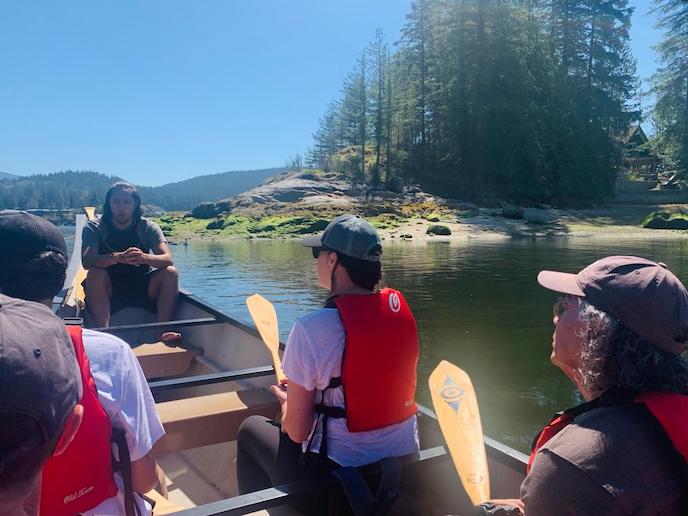
Recognizing the important role that reconciliation plays in its work, the Clear Seas team has incorporated the recommendations of the Truth and Reconciliation Commission into their work. This includes working to decolonize language on its website and communications along with incorporating Indigenous perspectives and Traditional Knowledge. Staff members and volunteers are completing certification on understanding the First Nations principles of OCAP – Ownership, Control, Access, and Possession – offered by the First Nations Information Governance Centre.
The future of reconciliation
The marine shipping industry is still finding its way on the path to reconciliation. The actions and programs outlined here illustrate what actions are being taken. As various organizations seek to act, the words of Dr. Marie Wilson, Truth, and Reconciliation Commissioner, speaking at the Banff Centre for Arts and Creativity at a Truth and Reconciliation Summit in 2016, provide a roadmap for action. “Sitting in corners wringing hands and wondering what to do is not going to advance anything, including yourself. Read the calls to action, (of the Truth and Reconciliation Commission) and as you go through them one at a time ask yourself: do I belong in this call?” Those words are as true today as they were then.
